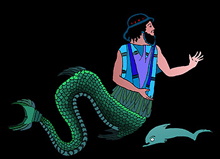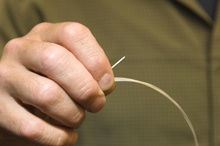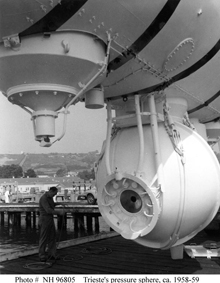Shape-shifting Nereus to Explore Deepest Ocean
Despite research and technological advances, 95 percent of the ocean remains unexplored. NOAA is the lead federal agency in an initiative to explore the ocean frontier. NOAA's Office of Ocean Exploration coordinates this effort by supporting expeditions and projects and developing ocean sensors and systems for the purpose of discovery and the advancement of knowledge.
- Introduction
- ROV...or AUV?
- Bringing Nereus to the Deep
- Technologic Marvels
- Returning to Great Depths
Note: pop quiz at the end!
In Greek mythology, Nereus was a god of the sea, with the power to foretell the future if he was caught. To avoid capture, he would change his shape.

The shape-shifting Nereus was known as the Old Man of the Sea and had the gift of prophecy.
The new Nereus will be a next-generation ocean exploration system, one that can change its shape as it explores 35,000 feet (11,000 meters) deep.
The Woods Hole Oceanographic Institution, with support from the National Science Foundation, NOAA, and the U.S. Navy, is currently developing this exciting new underwater explorer.
ROV...or AUV?
For years, remotely operated vehicles (ROVs) have used armored cables to connect ship-based operators to complex undersea vehicles. In recent decades, a new class of robots—autonomous underwater vehicles (AUVs)—have cut the cord.

Designs show the vehicle Nereus in its two modes. The vehicle will transform from a free-swimming vehicle for wide-area ocean surveys (top) to a vehicle tethered by a cable to a surface ship for close-up investigation and sampling of seafloor rocks and organisms (bottom). Three-dimensional rendering by Jack Cook, Woods Hole Oceanographic Institution.
The new Nereus exhibits something of a split personality in that it can be a tethered ROV or an untethered, programmed AUV. In its basic AUV mode, it is much like other AUVs. It accepts mission programming and executes the mission on its own, without operator feedback. It then returns to the ship and offers up its data to waiting scientists.
But the Nereus can change modes. With an ROV module, additional lights, cameras, and sampling tools are added to the vehicle. Nereus then operates at the end of a wire connected to a "pilot" who controls the vehicle using a joystick on the research vessel.
The new Nereus is a hybrid ROV, or an HROV. This novel combination of technologies is yielding a new class of undersea systems, able to change as mission requirements change. The old Nereus would be proud.
Bringing Nereus to the Deep
What does it all mean? No existing undersea research vehicle, manned or robotic, can operate below 21,000 feet (6,500 meters). After sea trials to 19,500 feet (6,000 meters) in the fall of 2007, and when Nereus becomes operational at 35,000 feet (11,000 meters) in the spring of 2008, it alone will reign supreme in the bottom 14,500 feet (4,500 meters) of the ocean. NOAA's Ocean Exploration program hopes to host the HROV on its new ship, the Okeanos Explorer, for a voyage back to the seafloor in 2008.
Nereus will use a wide variety of new technology to take sensors, lights, cameras, and a manipulator arm to the deepest ocean areas—to the bottom of trenches formed where one tectonic plate is subducted under another. Plate pressures, when suddenly released in those areas, have produced undersea earthquakes, landslides, and tsunamis. Nereus will be a valuable new tool to survey and sample those deep areas.
The $6 million HROV is being developed by engineers at the Woods Hole Oceanographic Institution (WHOI) Deep Submergence Lab. The engineers are using the best of 21st century technology to develop this new tool to bring science to great depths. Major funding for Nereus is being provided by the National Science Foundation, with additional funds from NOAA's Office of Ocean Exploration and Undersea Research Program. The HROV is also funded by the U.S. Navy, and the Navy's Space and Naval Warfare Systems Command Laboratory in San Diego, California, is adapting Navy technology in wire guidance for use with Nereus.
Technologic Marvels
Nereus' small fiber tether is a big part of the hybrid's operation in the ROV mode, and it is a great example of how Nereus will employ advanced technology. Other deep-sea ROVs require sizable shipboard winches and large reels spooled with heavy armored wire. The shipboard support system for this can be the size of a large motor home. The micro-thin fiber optic tether used by the Nereus trails out as far as 25 miles (40 kilometers) and fits in a box the size of a small microwave oven. With this reduction in size and weight, Nereus may be deployed on smaller vessels including those without Dynamic Positioning, a satellite-based positioning system that is critical to safe operation of traditional heavy ROVs.
Nereus' tether is so thin that a nine-pound fish could break it, so Nereus is programmed to operate as an AUV when separated from its ROV tether. Andy Bowen, WHOI's Project Manager for Nereus, is confident about the hybrid's ability to find its way home. "The vehicle knows where it is and tracks its progress underwater through acoustic and inertial navigation systems," he said. "It will find its way back to the ship, or to wherever it's programmed to surface."
Asked why there are 25 miles (40 kilometers) of fiber optic tether when the ocean is only seven miles (11 kilometers) deep, Bowen explained, "One good reason is that Nereus is expected to operate in the ROV mode laterally, especially under ice in the Polar regions."

A sample of fiber optic cable 1/32 of an inch thick. Image courtesy of Tom Kleindinst, Woods Hole Oceanographic Institution.
Other technology advances will run deep with Nereus. It will include the first use of high-performance ceramics for full ocean depth flotation, achieving an estimated 40 percent weight savings over more traditional syntactic foam material for flotation. To protect electrical components at depth, Nereus will also use high-performance ceramic materials, resulting in a 60 percent weight savings over traditional titanium. Advanced and lightweight imaging and lighting are also part of the vehicle's design. All these advancements make the HROV smaller and lighter, and thus able to travel further underwater.
For power in both the ROV and AUV modes, Nereus will use small cells such as those found in laptop computers. Two-thousand cells will need to be bundled for the HROV to power its four thruster engines and its onboard complement of sensors and systems. Nereus will have power to operate for 36 hours as an AUV and between 20 and 24 hours in tethered mode.
Returning to Great Depths

Close-up view of the front of Trieste's pressure sphere, showing the plexiglass window and instrument leads. This photo was taken circa 1958-59, shortly after Trieste was obtained by the Navy. Image courtesy of the U.S. Naval Historical Center.
Only two humans have been to the deepest part of the ocean—nearly seven miles (11 kilometers) below the surface at Challenger Deep in the Mariana Trench. In 1960, Jacques Piccard and Navy Lt. Donald Walsh spent just 20 minutes on the seafloor in the Navy's Trieste submersible. At a depth of more than 35,000 feet (11,000 meters), Challenger Deep is as deep as the height at which jets fly, and it is a mile deeper than Mt. Everest is high. No person has been that deep since Trieste's 1960 voyage. Trieste is now in a museum and was never replaced.
In later years, scientists worked with the Japanese robotic system Kaiko, which was then the only tool in the world capable of reaching the very bottom of the ocean. Sadly, the Kaiko was lost in rough seas in 2003.
"This HROV is very exciting technology," said Barbara Moore, Director of NOAA's Undersea Research Program. "It will provide capability to take our national science program to the deepest ocean for the first time since Trieste made its historic dive more than 45 years ago."
Despite decades of progress exploring our ocean planet, our ocean frontier remains essentially unexplored. With new technology and operational flexibility such as found in Nereus, we will significantly enhance our ability to better understand our largely unknown ocean and its inhabitants, perhaps including old Nereus.
Pop Quiz: Which Nereus changes its shape? The old and wise mythological Greek god of the sea? Or the new Nereus, under development to explore 35,000 feet (11,000 meters) deep, down to the very bottom of the ocean where no other exploration or research vehicle can reach?
Answer: Both!
Contributed by Justin Manley and Fred Gorell, NOAA's Office of Oceanic and Atmospheric Research
